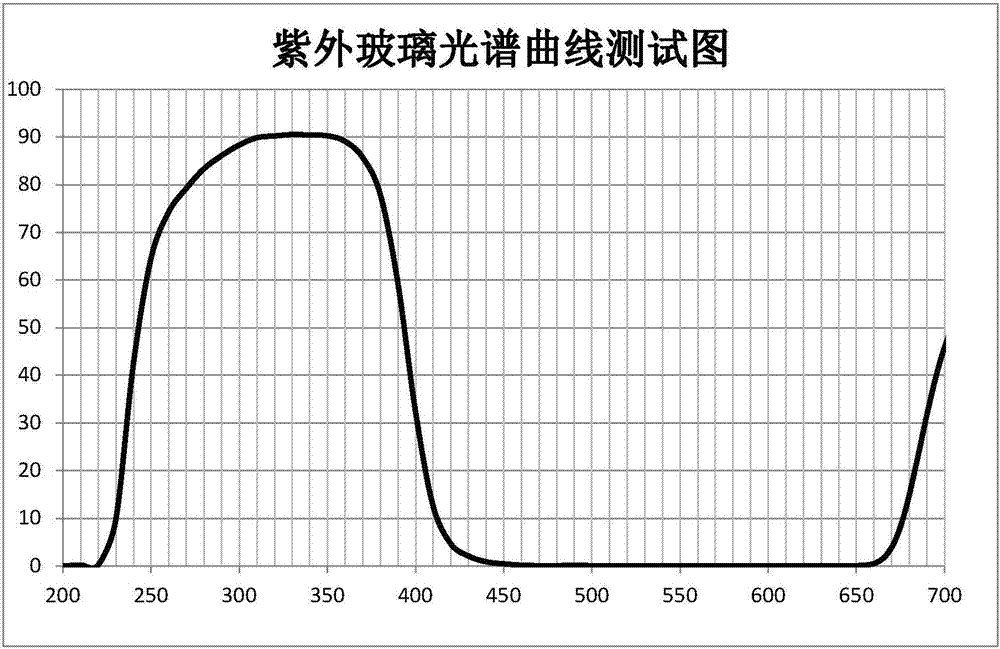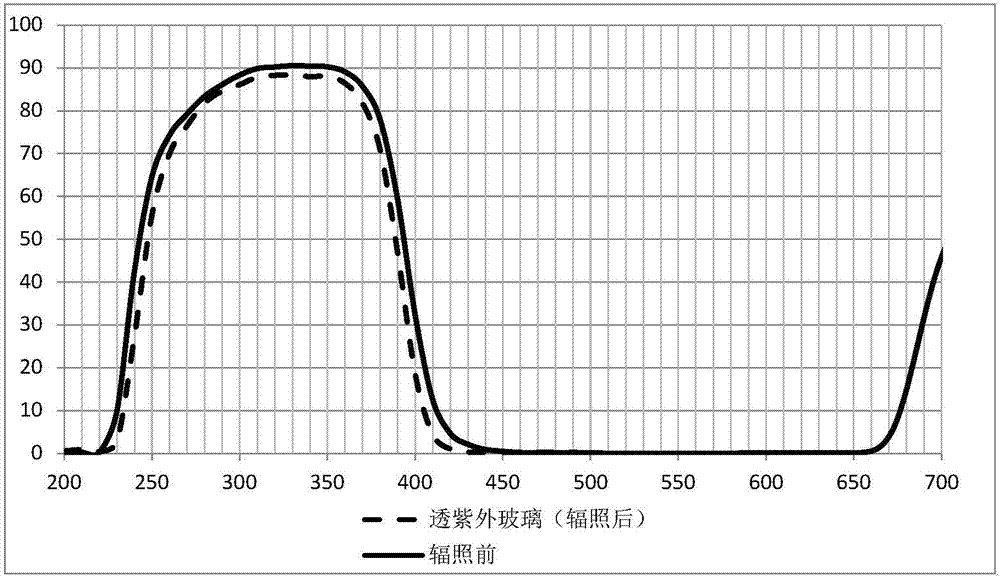Ultraviolet-radiation-resistant optical glass high in ultraviolet band transmittance
A technology of ultraviolet band and optical glass, applied in the field of optical glass, can solve the problems of low transmittance of ultraviolet band, decline of transmittance of ultraviolet part, cost waste, etc., achieve excellent ultraviolet anti-aging performance, improve the internal structure of glass, The effect of improving transmittance
- Summary
- Abstract
- Description
- Claims
- Application Information
AI Technical Summary
Problems solved by technology
Method used
Image
Examples
Embodiment 1
[0040] In this embodiment, the optical glass with high transmission in the ultraviolet band and resistant to ultraviolet radiation includes the following components in parts by weight:
[0041] 60 parts of phosphoric acid, 13 parts of boric acid, 8 parts of alumina, 4 parts of barium carbonate, 4 parts of potassium carbonate, 3 parts of calcium carbonate, 1 part of cobalt oxide, 2 parts of nickel oxide, 0.5 parts of tartaric acid, 0.5 parts of cerium oxide, strontium oxide 0.25 servings.
[0042] After the above-mentioned raw materials are mixed uniformly, the feeding temperature is 1230 ° C, the material is fully dissolved, and then the feeding is added for a total of 6 times, and the interval between each feeding is about 30 minutes; after the feeding is completed, the temperature is raised to 1330 ° C, and the heating time is 1 hour; 1330°C for 4 hours. The temperature was lowered from 1330°C to 1160°C, the cooling time was 1 hour, and the discharge temperature was about 1...
Embodiment 2
[0045] In this embodiment, the optical glass with high transmission in the ultraviolet band and resistant to ultraviolet radiation includes the following components in parts by weight:
[0046] 65 parts of phosphoric acid, 14 parts of boric acid, 10 parts of alumina, 5 parts of barium carbonate, 5 parts of potassium carbonate, 4 parts of calcium carbonate, 1.5 parts of cobalt oxide, 2.5 parts of nickel oxide, 0.8 parts of tartaric acid, 0.6 parts of cerium oxide, strontium oxide 0.3 servings.
[0047] After the above-mentioned raw materials are mixed uniformly, the feeding temperature is 1230 ° C, the material is fully dissolved, and then the feeding is added for a total of 6 times, and the interval between each feeding is about 30 minutes; after the feeding is completed, the temperature is raised to 1330 ° C, and the heating time is 1 hour; 1330°C for 4 hours. The temperature was lowered from 1330°C to 1160°C, the cooling time was 1 hour, and the discharge temperature was ab...
Embodiment 3
[0050] In this embodiment, the optical glass with high transmission in the ultraviolet band and resistant to ultraviolet radiation includes the following components in parts by weight:
[0051] 70 parts of phosphoric acid, 15 parts of boric acid, 12 parts of alumina, 6 parts of barium carbonate, 6 parts of potassium carbonate, 5 parts of calcium carbonate, 1.8 parts of cobalt oxide, 2.8 parts of nickel oxide, 1 part of tartaric acid, 0.7 parts of cerium oxide, oxide Strontium 0.3 parts.
[0052] After the above-mentioned raw materials are mixed uniformly, the feeding temperature is 1230 ° C, the material is fully dissolved, and then the feeding is added for a total of 6 times, and the interval between each feeding is about 30 minutes; after the feeding is completed, the temperature is raised to 1330 ° C, and the heating time is 1 hour; 1330°C for 4 hours. The temperature was lowered from 1330°C to 1160°C, the cooling time was 1 hour, and the discharge temperature was about 11...
PUM
 Login to View More
Login to View More Abstract
Description
Claims
Application Information
 Login to View More
Login to View More - R&D
- Intellectual Property
- Life Sciences
- Materials
- Tech Scout
- Unparalleled Data Quality
- Higher Quality Content
- 60% Fewer Hallucinations
Browse by: Latest US Patents, China's latest patents, Technical Efficacy Thesaurus, Application Domain, Technology Topic, Popular Technical Reports.
© 2025 PatSnap. All rights reserved.Legal|Privacy policy|Modern Slavery Act Transparency Statement|Sitemap|About US| Contact US: help@patsnap.com



